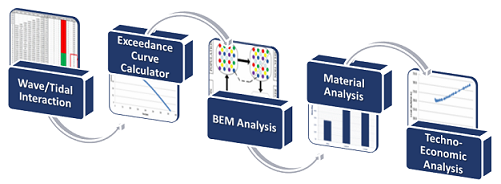Methodology for a Decision Support Tool for a Tidal Stream Device
MSc Sustainable Engineering: Offshore Renewable Energy


Further Work
Due to the wide scope adopted for the project, focusing on delivering a compact package of tools covering most aspect of a Tidal Stream Energy Project, each of the five tools have further possibilities of improvement. Some of them are described here, to make it easier to future researching groups to identify and work on them.

Diagram of Tool workflow
Wave/Tidal Interaction Tool
Further studies into the velocity effects could be carried out in several areas to enhance the programme. Future studies could include:• More detailed analysis on the bottom shear profile taking into accounts different bottom conditions (for example, rock,
sand, mud)
• Wave spectrum data and/or multiple wave interaction simulations
• Non-linear effects of waves for extreme conditions (large breaking waves with a varying wave steepness value)
All of these studies would enhance the sensitivity of the programme and would potentially allow more sites to be exploited. The programme at the moment uses a conservative approach to sizing the diameter of which further studies or test data could allow a larger rotor to be placed at that site.
Exceedance Curve Calculator
The main area for further work in the exceedance tool is to improve the sampling accuracy for the tidal data. This could be done by using real data measured from the site rather than using data taken from the tidal almanac. By using real data there would be no need to statistically estimate the values between neaps and springs as well as for the points between the known hourly speeds from the almanac. This would improve the accuracy and give a better gauge of the tidal flow rates at the site.Blade Element Momentum Analysis Software
As has already been mentioned, HARP_Opt is a state-of-art tool which incorporates multiples challenges and has big difficulties to be used. Additionally it has some limitations related to its application to the design of plastic materials (like GFRP or CFRP).To deal with this, it has been gone through the Matlab code and spotted different ways to make it useful also for this kind of materials. Since the tool is unable to increase the thickness at will (due to geometrical limitations) it is important to enable the tool to use blade families with bigger thicknesses in certain parts of the radius, and use its associated Drag and Lift coefficients, to allow that the strains (and subsequently the stresses) do not exceed the allowable limits.
Material Analysis Tool
The incorporation of the hydrofoil profile into this analysis is crucial because it is these parts of the blade which are subject to significant variations in flow velocity and loading during one rotation of the rotor. Therefore this would likely provide some more interesting results.A fuller analysis would also include: detailed velocity profiles over a year at a higher resolution, turbulence intensity from the site, exact geometrical properties of the material, and bucking analysis.
Techno-economical Analysis Tool
It is undeniable that predicting the whole cash flow over the duration of the project is definitely very challenging and is inherently uncertain. However, the possibility of a having a database of the different Tidal Stream projects that are being developed nowadays around the world would make the predictions way more accurate.Additionally, including a more advanced multi-variable sensitivity analysis tool would enable the user of the tool to have even more confidence in the results.